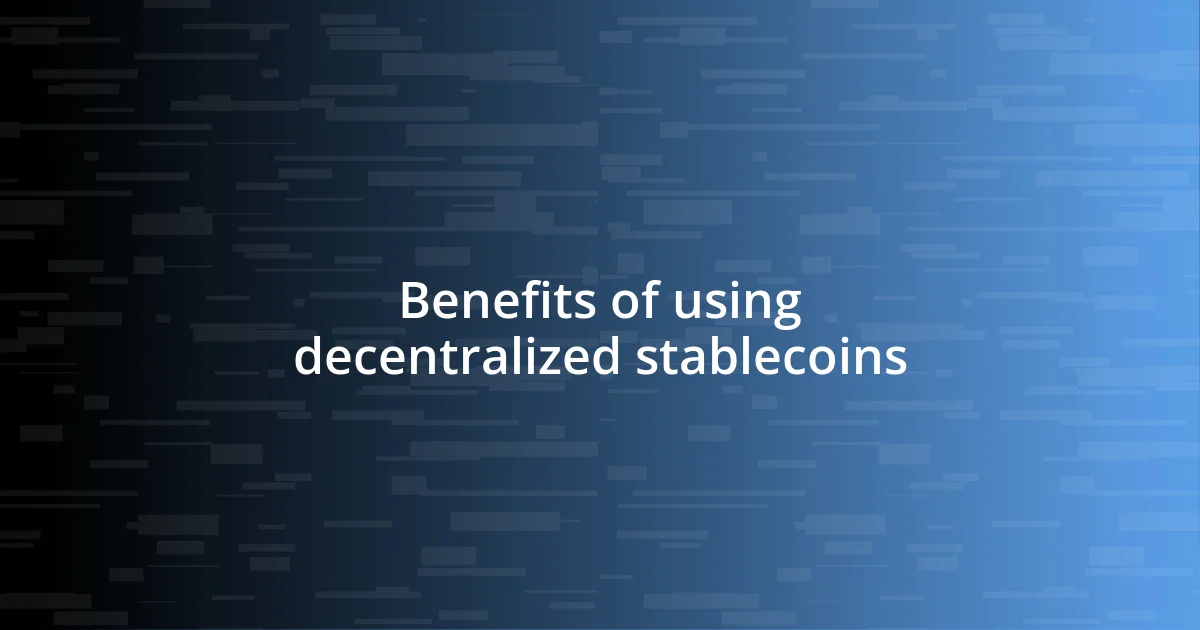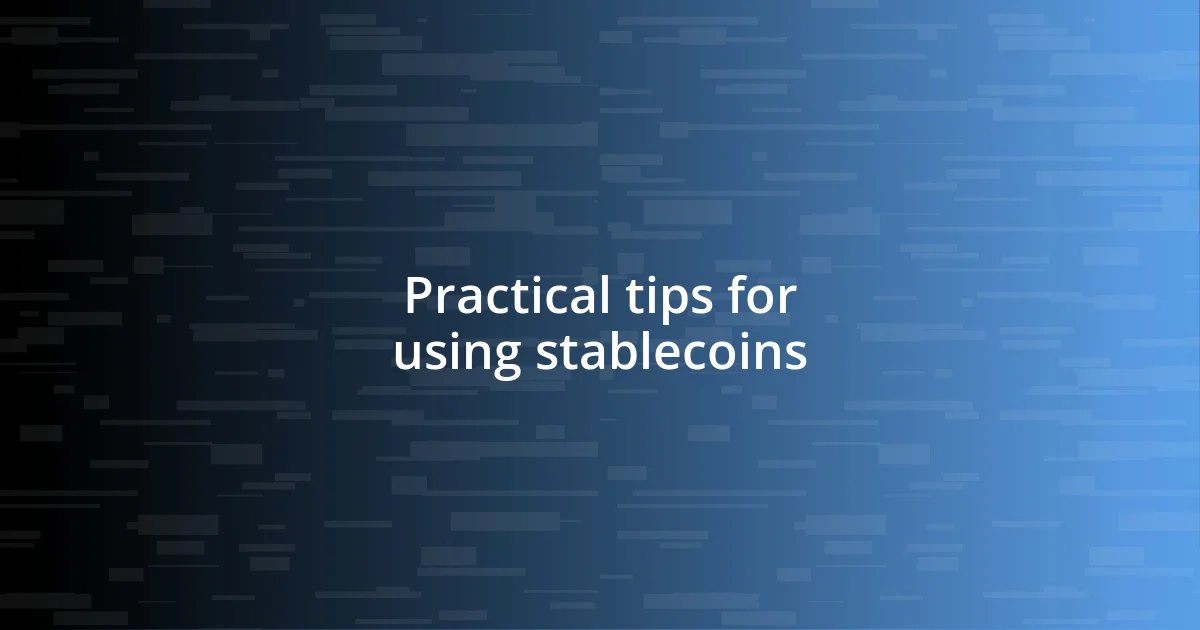Key takeaways:
- Decentralized stablecoins offer stability and autonomy by utilizing smart contracts, collateralization, and innovative mechanisms, challenging traditional financial systems.
- While offering benefits like transparency, accessibility, and reduced fees, decentralized stablecoins also face significant challenges including trust issues, regulatory scrutiny, and security vulnerabilities.
- The future of decentralized stablecoins includes potential advancements in algorithmic stability, integration into mainstream commerce, and evolving regulatory landscapes that could greatly influence their adoption and use.

Understanding decentralized stablecoins
Decentralized stablecoins are fascinating because they aim to combine the best of both worlds: the stability of traditional fiat currencies and the innovative power of blockchain technology. I remember when I first stumbled upon this concept; I thought, “Can something truly be stable in such a volatile space?” The idea that a digital asset could maintain a consistent value while eliminating the control of central authorities felt groundbreaking.
One of the striking features of decentralized stablecoins is their reliance on smart contracts and collateralization, which means they aren’t dependent on a single entity for their value. I was amazed by projects that use algorithms to automatically adjust the supply in response to market shifts. It made me question the very nature of currency and how much trust we really place in traditional systems. When you realize that you can hold a stablecoin without a bank, it feels liberating!
As I delved deeper, I found it fascinating how different frameworks address volatility. For instance, some stablecoins are backed by other cryptocurrencies, while others aim for a dollar-pegged value through complex mechanisms. This got me thinking: what if we could really democratize financial systems through innovative solutions like these? It’s incredibly thrilling to ponder the possibilities and imagine a future where our financial interactions are governed by transparency and decentralization.

Benefits of using decentralized stablecoins
The benefits of using decentralized stablecoins truly resonate with me, especially when I think back to my experiences navigating the traditional financial system. There’s an undeniable sense of empowerment that comes with removing intermediaries like banks. Just imagine how liberating it feels to have control over your funds without worrying about access restrictions or hidden fees. For example, once, while transferring money internationally, I faced exorbitant charges and delays from my bank. With decentralized stablecoins, those issues vanish.
- Transparency: Transactions are recorded on the blockchain, so you can track where your money goes.
- Accessibility: Anyone with internet access can engage in crypto transactions, breaking down barriers to entry.
- Stability: They maintain a steady value, helping users avoid the wild price swings often seen in cryptocurrencies.
- Reduced fees: By bypassing traditional institutions, users save on costs commonly associated with transactions.
- Financial inclusion: They offer users in underbanked regions a pathway to participate in the global economy.
Thinking about these advantages really highlights how decentralized stablecoins could transform lives. My encounters have made it clear to me that the financial landscape is shifting, and being part of that evolution feels invigorating. Each time I use a decentralized stablecoin for a transaction, I feel like I’m participating in something much larger than myself—a movement toward greater autonomy and equity in finance.

Challenges faced with decentralized stablecoins
Decentralized stablecoins do face several challenges, which can be quite eye-opening. One of the major hurdles is the issue of trust in the underlying collateral. I remember a time when I put my faith in a stablecoin backed by volatile assets, and I was left sweating bullets when I saw its value wobbling unexpectedly. Relying on cryptocurrency as collateral can quickly turn into a slippery slope if the market tanks, raising the question: Can we really trust a system that hinges on such uncertainty?
Another challenge is regulatory scrutiny. As I navigated through various projects, I realized just how much government regulations can create friction. For instance, I once participated in a community forum where a stablecoin project faced backlash due to potential compliance issues. It got me thinking about how these regulations can stifle innovation and, ironically, hinder the very decentralization that we’re trying to achieve. The tension between compliance and the ethos of decentralization is something I have found particularly alarming.
Security vulnerabilities also pose a significant concern. During my exploration, I saw multiple news reports about hacks targeting protocols. I couldn’t help but feel a sense of dread imagining one of my investments being compromised. These incidents remind us that a strong system is only as good as its weakest link, emphasizing the importance of robust security measures in the world of decentralized finance.
| Challenge | Description |
|---|---|
| Trust in Collateral | Reliance on volatile cryptocurrency backing can lead to instability. |
| Regulatory Scrutiny | Government regulations may hinder innovation and compliance with decentralized ideals. |
| Security Vulnerabilities | Risks of hacks and breaches expose the weaknesses in protocols. |

My personal journey with stablecoins
My personal journey with stablecoins began out of sheer curiosity. The moment I first heard about them, I was intrigued by the idea of a digital asset that promised to maintain a steady value. I still remember my excitement when I transferred a small amount to test the waters—no more volatile swings like I had experienced with other cryptocurrencies. It felt almost surreal to make a transaction without worrying if my funds would plummet in value overnight.
As I dug deeper into decentralized stablecoins, I became captivated by their potential for financial inclusion, especially for those in underbanked regions. One evening, I joined an online discussion where participants shared stories about how these stablecoins enabled them to bypass traditional banking barriers. Hearing about their journeys made me reflect on my own privileges and how accessible finance had always been for me. Could my experiences inspire others to embrace this new system?
However, the path hasn’t always been smooth. I recall a moment of panic when I was affected by a sudden de-pegging of a stablecoin I was using for transactions. The rush of uncertainty was unsettling, making me question the resilience of these digital assets. It’s moments like these that prompt me to ask: How can we feel secure when the systems we trust are built on such fragile foundations? Despite these challenges, I remain hopeful and engaged in the conversation around decentralized finance. It’s a continuously evolving landscape, and I’m excited to see where it leads.

Practical tips for using stablecoins
When I first dived into the world of stablecoins, I quickly realized the importance of doing thorough research before committing any funds. I remember scanning forums and whitepapers late into the night, eager to understand the mechanisms behind different stablecoins. Have you ever felt that rush of education when you uncover an essential detail? It’s empowering to know what you’re investing in, especially in such an unpredictable market.
Another practical tip I found invaluable is diversifying your holdings. While it might be tempting to go all-in on a single stablecoin, spreading your assets across a few options can mitigate risk. I had a friend who learned this lesson the hard way; they relied solely on one stablecoin, and a sudden market shift left them scrambling. Imagine the stress of watching your investment plummet when simple diversification could have saved the day!
Lastly, staying updated on the regulatory landscape is crucial. I recall a moment of alarm when I learned about impending regulations that could affect my favorite stablecoin. I realized that being proactive—by following news outlets and engaging with community discussions—helped me prepare for potential changes. It’s essential to keep your ear to the ground; otherwise, you might find yourself caught off guard. How do you stay informed about the evolving world of decentralized finance? What strategies do you use to ensure you’re not blindsided?

Future trends in decentralized stablecoins
As I look ahead, I can’t help but ponder the increasing sophistication of decentralized stablecoins. We’re seeing innovations like algorithmic models that aim to enhance stability and minimize the risk of de-pegging events. I often wonder, will these algorithms truly stand the test of time, or will they introduce new vulnerabilities that we haven’t yet conceived?
One exciting trend that’s been on my radar is the integration of decentralized stablecoins into everyday commerce. Recently, I had a chat with a small business owner excited about accepting stablecoins as payment. This shift towards mainstream adoption could transform how we view currency and transactions. Could we be on the brink of seeing decentralized stablecoins facilitating global commerce without the constraints of traditional banking?
I find myself particularly intrigued by the evolving regulatory landscape surrounding decentralized stablecoins. Governments are starting to pay closer attention, and this could shape the future in profound ways. As someone who has navigated this world, I can’t help but feel a mix of anticipation and concern. How will regulation balance innovation with safety? The answers could change the way we interact with these digital assets forever.














